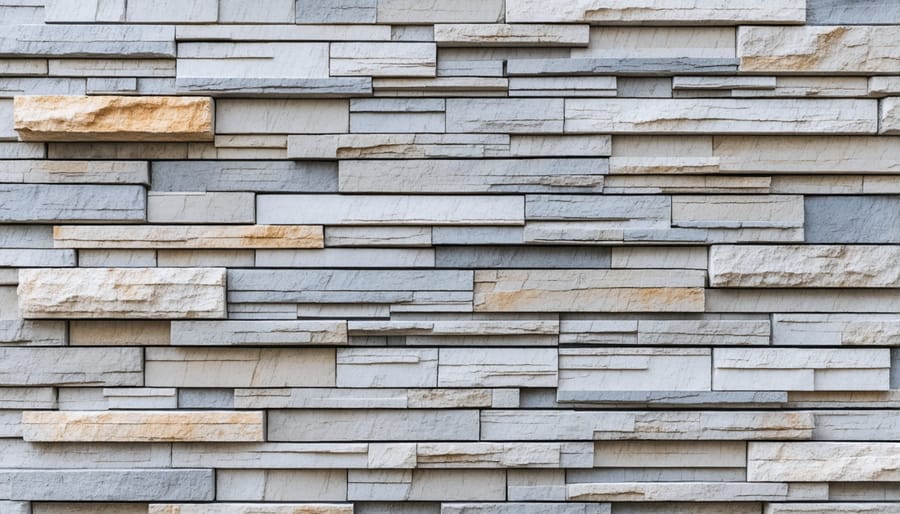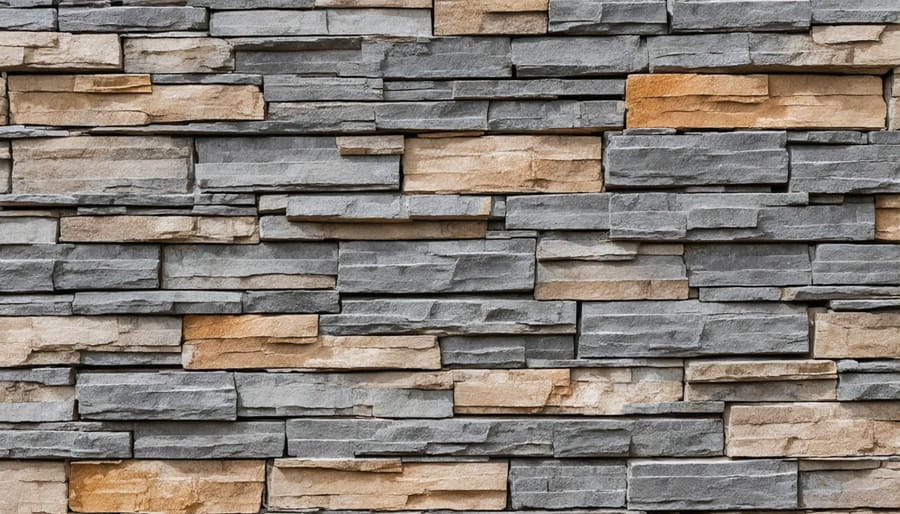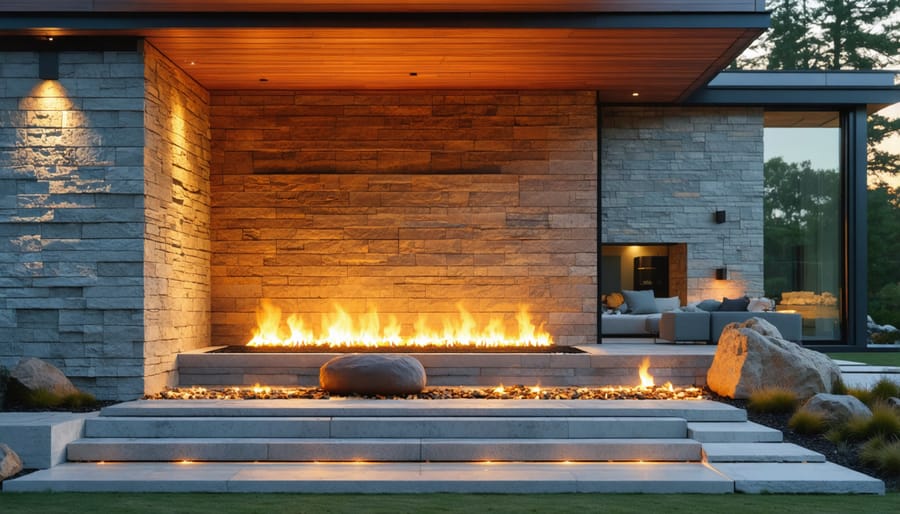Thermal performance shapes every aspect of modern building design, fundamentally impacting energy efficiency, occupant comfort, and sustainability goals. Natural stone, with its inherent thermal mass properties, has emerged as a cornerstone material in modern architectural applications, offering exceptional heat retention and temperature regulation capabilities.
Understanding stone’s thermal behavior unlocks significant advantages in building performance. Dense materials like granite and marble absorb heat slowly during peak temperatures and release it gradually during cooler periods, creating a natural temperature buffering effect. This passive temperature control can reduce HVAC demands by 10-30%, depending on climate conditions and implementation.
Recent advances in thermal imaging and building science have revealed optimal ways to harness stone’s thermal properties. Strategic placement of stone elements, proper thickness calculations, and innovative installation methods now allow designers to maximize these benefits while meeting increasingly stringent energy codes. Whether in residential facades, commercial interiors, or large-scale institutional projects, thermal performance has become a critical factor in natural stone selection and application.
Understanding Thermal Properties of Natural Stone
Thermal Mass and Heat Capacity
Natural stone possesses remarkable thermal mass properties, making it an excellent material for regulating indoor temperatures and enhancing building energy efficiency. This inherent characteristic allows stone to absorb, store, and gradually release heat throughout daily temperature cycles.
The heat capacity of natural stone, typically ranging from 0.7 to 2.3 kJ/kg·K depending on the variety, enables it to absorb significant amounts of heat energy while maintaining relatively stable temperatures. During warm periods, stone surfaces absorb excess heat from the environment, helping to keep interior spaces cooler. As temperatures drop, the stored heat is slowly released back into the space, creating a natural warming effect.
This thermal storage capability proves particularly beneficial in climates with substantial temperature fluctuations between day and night. For example, in desert regions, thick stone walls can absorb intense daytime heat and release it during cool nights, helping maintain comfortable indoor temperatures with reduced reliance on mechanical heating and cooling systems.
The effectiveness of stone’s thermal mass depends on several factors, including:
– Stone thickness and density
– Surface area exposure
– Color and finish of the stone
– Location and orientation within the building
– Local climate conditions
When properly incorporated into building design, stone’s thermal mass properties can contribute significantly to energy savings and improved thermal comfort throughout the year. This passive temperature regulation makes natural stone an environmentally conscious choice for sustainable architecture.

Thermal Conductivity and Resistance
Natural stone materials exhibit diverse thermal conductivity properties, which significantly impact their performance in building applications. Granite, for example, demonstrates excellent thermal conductivity, making it an effective material for heat distribution. With conductivity values ranging from 2.0 to 4.0 W/(m·K), granite can effectively transfer heat, making it ideal for applications like fireplace surrounds and kitchen countertops.
Marble exhibits moderate thermal conductivity, typically between 1.2 to 3.0 W/(m·K), allowing it to maintain relatively stable temperatures. This characteristic makes marble particularly suitable for interior flooring in climate-controlled environments. Limestone and sandstone, with lower conductivity values around 1.5 to 2.5 W/(m·K), provide better thermal resistance, helping to regulate indoor temperatures more effectively.
The thermal resistance of stone, measured in R-values, varies based on thickness and composition. Denser stones generally offer lower R-values but higher thermal mass, which can be advantageous in specific climate conditions. This property allows stone to absorb heat during peak temperatures and release it gradually when temperatures drop, contributing to natural temperature regulation.
Understanding these thermal properties is crucial for optimal material selection in construction projects. For instance, higher thermal mass stones can reduce heating and cooling costs in regions with significant daily temperature fluctuations, while stones with better insulating properties might be more suitable for exterior cladding in extreme climates.
Factors Affecting Stone’s Thermal Performance
Stone Type and Composition
Different stone varieties exhibit distinct thermal characteristics that significantly impact their performance in various applications. Dense stones like granite and basalt typically offer superior thermal mass properties, effectively storing and gradually releasing heat. Marble, while moderately dense, provides balanced thermal performance and is often chosen for interior applications. Limestone and sandstone, being more porous, generally have lower thermal conductivity, making them suitable for specific climate-controlled environments.
The mineral composition of natural stone directly influences its thermal behavior. Quartz-rich stones like granite demonstrate excellent heat retention, while calcite-based stones like marble respond more quickly to temperature changes. Making informed decisions about stone type selection requires understanding these inherent properties.
Color also plays a crucial role in thermal performance. Darker stones typically absorb more solar radiation, while lighter-colored stones reflect more heat. This characteristic becomes particularly important in exterior applications where solar heat gain is a consideration. The stone’s finish, whether polished, honed, or textured, can further modify its thermal behavior by affecting how it interacts with radiant heat.
Installation Methods
The installation method of natural stone significantly impacts its thermal performance. Proper installation techniques can enhance the stone’s natural insulating properties while poor installation can create thermal bridges and reduce efficiency. When installing stone cladding, maintaining consistent air gaps between the stone and building structure creates an additional insulation layer. This cavity also helps manage moisture and prevents heat transfer.
For interior applications, direct-adhered stone should be installed over a proper substrate with appropriate waterproofing and vapor barriers. The thickness and type of setting material can affect heat transfer rates. Using thermal breaks at critical junctions prevents unwanted heat loss or gain through the building envelope.
Ventilated facade systems, particularly popular in commercial applications, optimize thermal performance by creating a chimney effect. This natural air circulation helps regulate temperature and moisture levels. The spacing of anchor points and selection of mounting systems should consider both structural requirements and thermal bridging potential.
For flooring installations, incorporating proper insulation beneath stone tiles and using appropriate underlayment materials can significantly improve thermal efficiency, especially when combined with radiant heating systems.

Environmental Conditions
Environmental conditions play a crucial role in how natural stone performs thermally in building applications. Temperature fluctuations, sun exposure, precipitation, and humidity levels all influence stone’s thermal behavior and overall effectiveness as a building material.
In hot climates, lighter-colored stones reflect more solar radiation, helping to reduce heat absorption and keeping interior spaces cooler. Darker stones, while aesthetically appealing, tend to absorb more heat and may contribute to increased cooling costs in sunny locations. However, this heat absorption property can be beneficial in colder climates where passive solar heating is desired.
Rainfall and humidity affect stone’s thermal performance by altering its moisture content. When stone absorbs moisture, its thermal conductivity increases, potentially reducing its insulating properties. This is particularly important in coastal areas or regions with high precipitation rates, where proper waterproofing becomes essential.
Wind exposure also impacts thermal performance, as air movement across stone surfaces can accelerate heat loss or gain. Buildings in windy locations may require additional consideration for joint sealing and insulation to maintain optimal thermal efficiency.
The orientation of stone installations relative to sun exposure should be carefully considered. South-facing walls in the Northern Hemisphere receive more direct sunlight and experience greater thermal stress, while north-facing surfaces maintain more stable temperatures but may be more susceptible to moisture-related issues.
Understanding these environmental factors is crucial for selecting appropriate stone types and designing effective installation systems that maximize thermal performance while ensuring long-term durability.

Optimizing Thermal Performance
Selection Criteria
When selecting natural stone for optimal thermal performance, several key factors must be considered. The stone’s thermal mass, density, and conductivity properties play crucial roles in determining its effectiveness for specific applications.
For exterior walls and facades, choose stones with higher thermal mass, such as granite or limestone, which can effectively absorb and store heat during the day and release it gradually at night. This characteristic helps maintain stable indoor temperatures and reduce energy costs.
Color selection significantly impacts thermal performance. Lighter-colored stones reflect more solar radiation, making them ideal for hot climates where heat reduction is priority. Darker stones absorb more heat, which can be beneficial in colder regions but may require additional insulation in warm areas.
Stone thickness is another critical consideration. Thicker stones provide better thermal mass benefits but must be balanced against structural requirements and cost considerations. Generally, a thickness of 2-3 inches offers optimal thermal performance for most applications.
Consider the stone’s porosity and water absorption rate, as these properties affect its thermal conductivity. Dense stones with lower porosity typically provide better thermal stability and are less susceptible to temperature fluctuations.
Local climate conditions should guide your selection. In areas with extreme temperature variations, choose stones with proven durability and resistance to thermal cycling. For coastal regions, select stones with demonstrated resistance to salt exposure and humidity while maintaining their thermal properties.
Finally, ensure the selected stone meets local building codes and energy efficiency requirements for your specific application.
Installation Best Practices
Proper installation is crucial for maximizing the thermal performance of natural stone materials. Following established installation techniques ensures optimal heat retention and transfer properties.
Start by ensuring a proper substrate preparation with adequate insulation backing. Install a high-quality vapor barrier to prevent moisture infiltration, which can compromise thermal efficiency. Maintain consistent joint spacing between stone units to allow for thermal expansion and contraction while preserving the integrity of the installation.
When installing stone cladding, create an air cavity between the stone and building envelope. This ventilated space helps regulate temperature and prevents heat buildup. Use appropriate anchoring systems and supports that minimize thermal bridging, which can reduce overall energy efficiency.
For interior applications, consider incorporating stone in areas that receive direct sunlight to capitalize on its thermal mass properties. Install thicker stone pieces in these locations, as they provide better heat storage capacity. When using stone flooring with radiant heating systems, ensure proper adhesive selection and maintain recommended thickness requirements for optimal heat distribution.
Seal all joints properly to prevent air leakage, and use appropriate expansion joints to accommodate thermal movement. Regular inspection during installation helps identify and address potential thermal weak points before project completion.
Maintenance Considerations
Regular maintenance is essential for preserving the thermal performance characteristics of natural stone installations. A well-maintained stone surface not only retains its aesthetic appeal but also maintains its thermal efficiency over time. The key to successful long-term maintenance lies in implementing proper cleaning protocols and periodic inspections.
Clean surfaces regularly with pH-neutral cleaners specifically formulated for natural stone to prevent the buildup of dirt and debris that can affect thermal conductivity. Avoid using acidic or abrasive cleaning products that might damage the stone’s surface structure and compromise its thermal properties. Pay special attention to grout lines and joints, as these areas can develop gaps that impact overall thermal performance.
Inspect stone installations annually for signs of wear, cracking, or deterioration. Address any issues promptly to prevent thermal bridges from forming. In exterior applications, ensure proper drainage systems remain functional to prevent water accumulation, which can affect the stone’s thermal behavior during freeze-thaw cycles.
For sealed stone surfaces, monitor the effectiveness of the sealant and reapply as recommended by the manufacturer. This helps maintain the stone’s natural thermal properties and protects against moisture infiltration that could impact its insulating capabilities. Professional assessment every few years can help identify potential issues before they affect the stone’s thermal performance significantly.
Natural stone’s thermal performance plays a crucial role in creating energy-efficient and comfortable spaces. Throughout this exploration, we’ve seen how different stone types exhibit unique thermal properties that can significantly impact building efficiency and occupant comfort.
The key takeaway is that natural stone’s high thermal mass makes it an excellent choice for passive temperature regulation. This characteristic allows stone to absorb heat during warm periods and release it when temperatures drop, creating a natural temperature buffering effect that can reduce heating and cooling costs.
When selecting natural stone for thermal performance, consider these essential recommendations:
Choose stones with higher thermal mass for areas requiring temperature stability. Granite, limestone, and marble are particularly effective choices for this purpose. Consider the local climate and building orientation when selecting stone types and applications.
Proper installation is crucial for optimal thermal performance. Ensure appropriate insulation backing and proper ventilation gaps in exterior applications. Regular maintenance and sealing help preserve stone’s thermal properties and extend its lifespan.
For exterior applications, lighter-colored stones generally reflect more solar radiation, making them ideal for hot climates. Darker stones, which absorb more heat, may be better suited for colder regions where solar heat gain is beneficial.
The integration of natural stone with modern building systems can enhance overall thermal efficiency. Consider combining stone elements with smart climate control systems and proper insulation strategies for maximum benefit.
Remember that while initial costs may be higher compared to some alternative materials, natural stone’s durability, thermal properties, and minimal maintenance requirements often result in lower lifetime costs and enhanced building performance.
By understanding and properly implementing natural stone’s thermal properties, architects, designers, and property owners can create more sustainable, comfortable, and energy-efficient spaces that stand the test of time.










